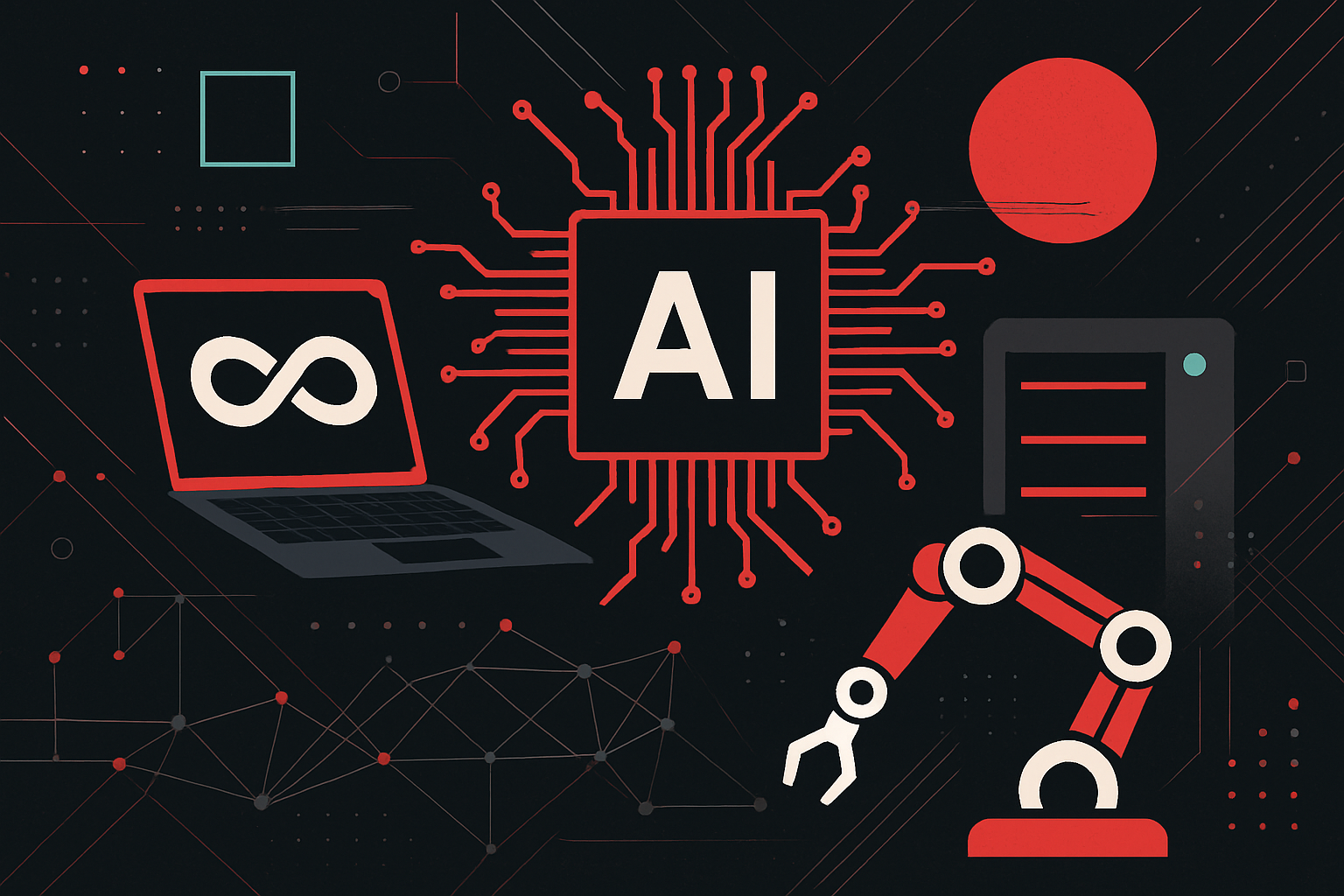The Evolution of DevOps: From Automation to AI-Driven Ops
Early DevOps: Automating the Pipeline
Key Drivers
- Elimination of manual errors
- Accelerated deployment cycles
- Consistent environments
Tools and Practices
| Function |
Tool Examples |
Outcome |
| Source Control |
Git, SVN |
Versioned code, collaboration |
| CI/CD Pipelines |
Jenkins, Travis CI |
Automated build, test, deploy |
| Configuration Mgmt. |
Ansible, Puppet |
Automated infrastructure provisioning |
| Monitoring |
Nagios, Zabbix |
Basic system and service checks |
Example: Jenkins Pipeline
pipeline {
agent any
stages {
stage('Build') {
steps {
sh 'make build'
}
}
stage('Test') {
steps {
sh 'make test'
}
}
stage('Deploy') {
steps {
sh './deploy.sh'
}
}
}
}
Actionable Insights
- Automate repetitive tasks: Focus on integrating build, test, and deployment workflows.
- Version infrastructure: Use Infrastructure as Code (IaC) to track environment changes.
- Monitor everything: Start with basic resource and service health.
The Shift to Infrastructure as Code and Immutable Deployments
Technical Advancements
- IaC enables reproducibility
- Containers isolate dependencies
- Immutable deployments reduce drift
Tools and Practices
| Area |
Tool Examples |
Benefits |
| IaC |
Terraform, CloudFormation |
Consistent, cloud-agnostic provisioning |
| Containers |
Docker, Podman |
Environment parity, fast deployments |
| Orchestration |
Kubernetes, Nomad |
Automated scaling, self-healing |
Example: Terraform Resource
resource "aws_instance" "web" {
ami = "ami-0c55b159cbfafe1f0"
instance_type = "t2.micro"
tags = {
Name = "WebServer"
}
}
Actionable Insights
- Adopt declarative configurations: Reduce manual changes and errors.
- Leverage containers: Simplify CI/CD and microservices deployment.
- Automate rollbacks: Use blue/green or canary strategies for safer releases.
Observability and Feedback Loops
Technical Explanations
- Logs, metrics, and traces: Collect telemetry for system insights.
- Automated alerting: Faster incident response.
- User-centric monitoring: Focus on SLOs and SLIs.
Tools and Practices
| Observability Type |
Tool Examples |
Use Case |
| Logging |
ELK (Elasticsearch, Logstash, Kibana), Fluentd |
Aggregated log search |
| Metrics |
Prometheus, Grafana |
Real-time dashboards, alerting |
| Tracing |
Jaeger, Zipkin |
Distributed transaction analysis |
Example: Prometheus Alert Rule
groups:
- name: instance_down
rules:
- alert: InstanceDown
expr: up == 0
for: 5m
labels:
severity: critical
annotations:
summary: "Instance {{ $labels.instance }} down"
Actionable Insights
- Instrument applications: Expose key metrics and logs.
- Implement service-level objectives: Measure reliability from the user’s perspective.
- Automate incident response: Integrate alerting with on-call tools.
AI-Driven Ops: The Next Leap
Technical Advancements
- Predictive analytics: Anomaly detection, failure prediction.
- Automated remediation: Self-healing scripts and workflows.
- Intelligent resource scaling: Dynamic, usage-based adjustments.
Tools and Practices
| AI-Ops Capability |
Tool Examples |
Benefit |
| Anomaly Detection |
Moogsoft, Dynatrace, Datadog |
Early detection of unusual patterns |
| Automated Remediation |
StackStorm, Rundeck |
Scripted responses to incidents |
| Intelligent Scaling |
Kubernetes HPA/VPA, Autopilot |
Resource efficiency, cost optimization |
Example: Kubernetes Horizontal Pod Autoscaler
apiVersion: autoscaling/v2
kind: HorizontalPodAutoscaler
metadata:
name: web-hpa
spec:
scaleTargetRef:
apiVersion: apps/v1
kind: Deployment
name: web
minReplicas: 2
maxReplicas: 10
metrics:
- type: Resource
resource:
name: cpu
target:
type: Utilization
averageUtilization: 70
Example: Anomaly Detection with Python (Prophet)
from prophet import Prophet
import pandas as pd
df = pd.read_csv('metrics.csv') # columns: ds, y
model = Prophet()
model.fit(df)
future = model.make_future_dataframe(periods=30)
forecast = model.predict(future)
# Anomalies can be detected where actuals deviate from forecast
Actionable Insights
- Integrate AI/ML with observability: Apply anomaly detection to logs and metrics for early warnings.
- Automate common fixes: Use runbooks and workflows that trigger on detected issues.
- Continuously retrain models: Adapt to changing system behavior and workloads.
Comparison Table: DevOps Evolution Phases
| Aspect |
Early Automation |
IaC & Immutable |
Observability |
AI-Driven Ops |
| Focus |
Speed, consistency |
Reproducibility |
Insights, feedback |
Prediction, self-healing |
| Tooling |
Jenkins, Ansible |
Terraform, Docker |
Prometheus, ELK |
Moogsoft, Datadog |
| Deployment |
Manual/Scripted |
Automated, containers |
Automated, monitored |
Autonomous, self-healing |
| Response |
Manual |
Semi-automated |
Alert-based |
Automated, predictive |
| Example |
Bash scripts |
Terraform modules |
SLO dashboards |
ML-based auto-remediation |
Practical Steps to Transition Toward AI-Driven Ops
- Instrument Everything: Ensure full-stack observability.
- Aggregate Data: Centralize logs, metrics, traces.
- Implement Automation: Use Infrastructure as Code for all provisioning and deployment.
- Integrate AI/ML: Start with anomaly detection and automated scaling.
- Automate Remediation: Define and script responses to frequent incidents.
- Continuously Improve: Review outcomes, retrain models, and expand automation scope.
Sample Workflow: Automated Incident Remediation
- Detection: AI system detects CPU anomaly.
- Diagnosis: Cross-references with deployment changes.
- Remediation: Triggers a rollback or scales pods via API.
- Notification: Sends summary to Slack/Teams channel with details and actions taken.
# Example StackStorm rule
---
name: cpu_anomaly_remediation
pack: autoops
description: Automatically scale pods on high CPU
trigger:
type: cpu.anomaly_detected
criteria:
trigger.utilization:
type: gt
pattern: 90
action:
ref: k8s.scale_pods
parameters:
deployment: web
replicas: 2
Key Takeaways Table
| Actionable Step |
Tools/Techniques |
Impact |
| Automate Pipelines |
Jenkins, GitHub Actions |
Speed, reliability |
| Adopt IaC and Containers |
Terraform, Docker |
Consistency, scalability |
| Implement Observability |
Prometheus, Grafana |
Faster troubleshooting |
| Integrate AI/ML for Detection/Response |
Datadog, Moogsoft |
Proactive incident handling |
| Automate Remediation |
StackStorm, Rundeck |
Reduce MTTR |





0 thoughts on “The Evolution of DevOps: From Automation to AI-Driven Ops”